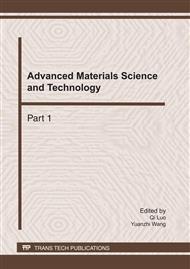[1]
N. Levanon and E. Mozeson, Radar signals. Wiley-IEEE Press, (2004).
Google Scholar
[2]
M. Bell, Information theory and radar waveform design, IEEE Transactions on Information Theory, vol. 39, no. 5, p.1578–1597, (1993).
DOI: 10.1109/18.259642
Google Scholar
[3]
D. Albanese, A. Klein, and I. Gilfillan, Pseudorandom code waveform design for CW radar, IEEE Transactions on Aerospace and Electronic Systems, p.67–75, (1979).
DOI: 10.1109/taes.1979.308797
Google Scholar
[4]
J. Li and P. Stoica, MIMO radar with colocated antennas, IEEE Signal Processing Magazine, vol. 24, no. 5, p.106–114, (2007).
DOI: 10.1109/msp.2007.904812
Google Scholar
[5]
A. Haimovich, R. Blum, and L. Cimini, MIMO radar with widely separated antennas, IEEE Signal Processing Magazine, vol. 25, no. 1, p.116–129, (2008).
DOI: 10.1109/msp.2008.4408448
Google Scholar
[6]
D. Fuhrmann and G. San Antonio, Transmit beamforming for MIMO radar systems using partial signal correlation, in Signals, Systems and Computers, 2004. Conference Record of the Thirty-Eighth Asilomar Conference on, vol. 1, (2004).
DOI: 10.1109/acssc.2004.1399140
Google Scholar
[7]
P. Stoica, J. Li, and X. Zhu, Waveform synthesis for diversity-based transmit beampattern design, IEEE Transactions on Signal Processing, vol. 56, no. 6, p.2593–2598, (2008).
DOI: 10.1109/tsp.2007.916139
Google Scholar
[8]
Y. Yang and R. Blum, MIMO radar waveform design based on mutual information and minimum mean-square error estimation, IEEE Transactions on Aerospace and Electronic Systems, vol. 43, no. 1, p.330–343, (2007).
DOI: 10.1109/taes.2007.357137
Google Scholar
[9]
B. Friedlander, Waveform design for MIMO radars, IEEE Transactions on Aerospace and Electronic Systems, vol. 43, no. 3, p.1227–1238, (2007).
DOI: 10.1109/taes.2007.4383615
Google Scholar
[10]
H. Deng, Polyphase code design for orthogonal netted radar systems, IEEE Transactions on Signal Processing, vol. 52, no. 11, p.3126–3135, (2004).
DOI: 10.1109/tsp.2004.836530
Google Scholar
[11]
H. Khan, Y. Zhang, C. Ji, C. Stevens, D. Edwards, and D. O'Brien, Optimizing polyphase sequences for orthogonal netted radar, IEEE Signal Processing Letters, vol. 13, no. 10, p.589–592, (2006).
DOI: 10.1109/lsp.2006.877143
Google Scholar
[12]
H. He, P. Stoica, and J. Li, Designing unimodular sequence sets with good correlationsłIncluding an application to MIMO radar, IEEE Trans. Signal Process, vol. 57, p.4391–4405, (2009).
DOI: 10.1109/tsp.2009.2025108
Google Scholar
[13]
E. Dinan and B. Jabbari, Spreading codes for direct sequence CDMA and wideband CDMA cellularnetworks, IEEE communications magazine, vol. 36, no. 9, p.48–54, (1998).
DOI: 10.1109/35.714616
Google Scholar
[14]
B. Sklar, Rayleigh fading channels in mobile digital communication systems. I. Characterization, IEEE Communications Magazine, vol. 35, no. 7, p.90–100, (1997).
DOI: 10.1109/35.601747
Google Scholar


